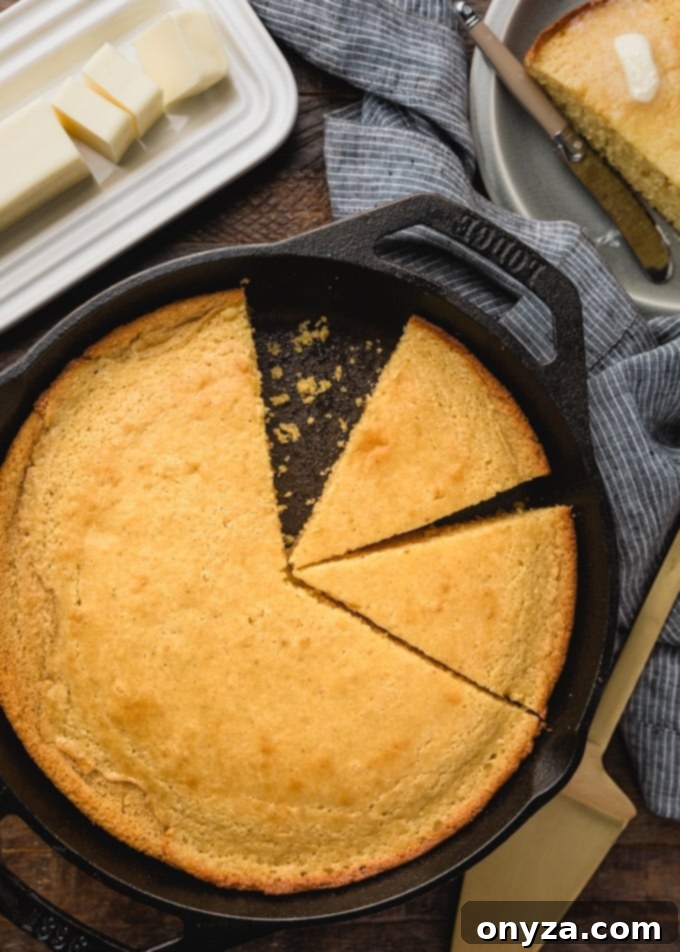Welcome, cornbread enthusiasts! This exceptional buttermilk cornbread recipe masterfully blends the beloved traditions of both Northern and Southern styles, resulting in an irresistibly moist and flavorful round that’s perfect for any occasion, from a hearty breakfast to a delightful dessert.
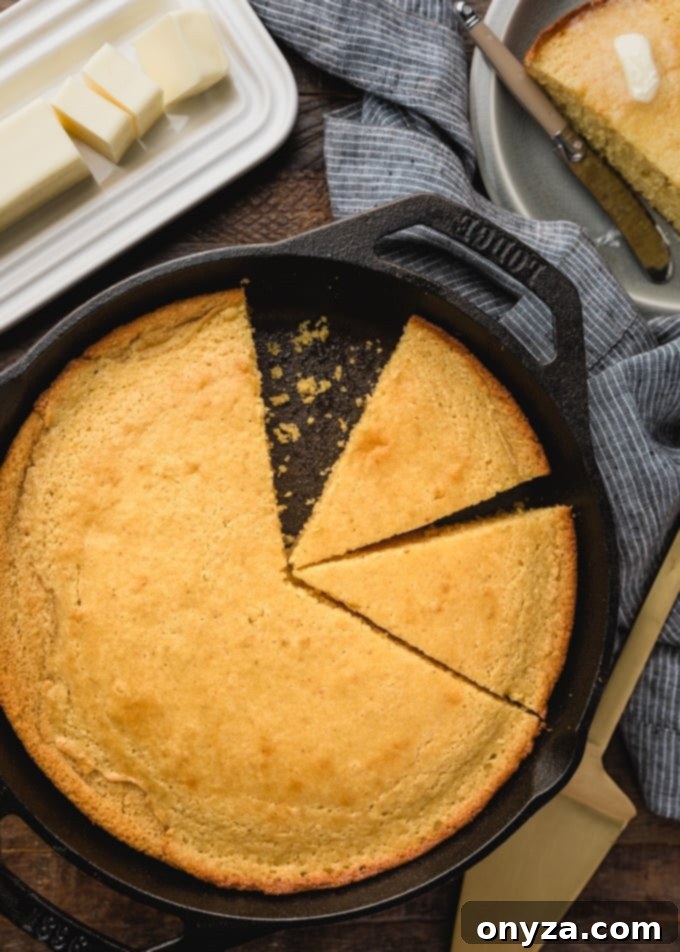
This article may contain affiliate links. As an Amazon Associate, I earn a commission (at no additional cost to you) from qualifying purchases made through these links. All recommendations and opinions expressed are genuinely my own.
The Ultimate Buttermilk Cornbread: A Perfect Blend of Northern Sweetness & Southern Savory Charm
There’s something uniquely comforting about a warm slice of cornbread. Imagine it, fresh from the oven, with a generous dollop of whipped butter slowly melting into its tender, crumbly texture. For many, including myself, cornbread isn’t just a side dish; it’s a culinary experience that can truly stand on its own as a fulfilling meal. This recipe aims to elevate that experience, offering a cornbread that captures the essence of diverse regional traditions.
Sweet vs. Savory: Navigating the Great Cornbread Divide
Having experienced life in both the Northern and Southern United States, I’ve had the pleasure of encountering cornbread in all its delightful forms. The differences between these regional styles are significant, often sparking passionate debates among food lovers.
My formative years in the North introduced me to cornbread that was distinctly sweet, remarkably fluffy, and cake-like in its consistency. It was a versatile staple, accompanying hearty chilis, soothing soups, and robust stews. Yet, its inherent sweetness often meant it could easily transition into a dessert, a role it frequently fulfilled.
Later, as an adult living in the South, I embraced the tradition of unsweetened, intensely cornmeal-forward recipes. These Southern versions, typically made with buttermilk and sometimes entirely without wheat flour, were often baked in a sizzling cast iron skillet, frequently seasoned with bacon grease. The result was a golden-crusted, savory cornbread, practically begging to be generously slathered with butter.
The “sweet versus savory” cornbread debate can be quite fervent, with strong opinions on both sides. However, I’ve always found it impossible to declare a favorite. My heart (and stomach) genuinely has room for all types of cornbread, appreciating the unique qualities each style brings to the table.
This particular buttermilk cornbread recipe was born from a desire to create a harmonious fusion. It represents a carefully crafted hybrid, designed to capture the very best elements of both Northern and Southern culinary traditions, delivering a truly unique and satisfying experience.

Crafting the Perfect Crumb: What Goes into This Buttermilk Cornbread
Achieving that ideal balance of fluffy yet crumbly texture, without any hint of dryness, relies on a thoughtful selection of ingredients. You’ll find most of these are standard baking staples readily available in any kitchen:
- All-Purpose Flour: Provides structure and contributes to the soft crumb.
- Granulated Sugar: Offers a delicate sweetness, bridging the gap between Northern and Southern styles. The amount can be adjusted to your personal preference.
- Baking Powder and Baking Soda: These leavening agents work in tandem with the acidic buttermilk to give the cornbread its characteristic lift and tender texture.
- Salt: A crucial flavor enhancer that balances the sweetness and deepens the savory notes.
- Eggs: Act as binders, adding richness and contributing to the overall structure and moisture.
- Unsalted Butter: Essential for both flavor and creating that desirable crisp crust. We use a generous amount for an unapologetically rich result.
For cornbread that is consistently moist, tender, and never dry, my recipe incorporates a delightful combination of buttermilk and sour cream into the batter. This creamy duo, paired with a stick of melted butter, ensures an incredibly moist texture and a rich, lightly sweet, and tangy flavor profile that is utterly irresistible.
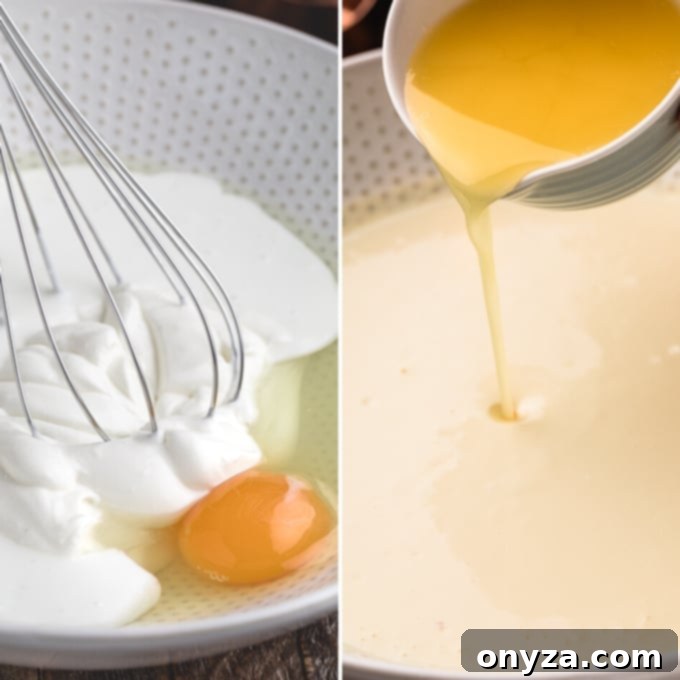
Whole Buttermilk vs. Low-Fat: Making the Right Choice
When available, I wholeheartedly recommend using whole buttermilk. Its higher fat content contributes to a richer flavor and a more tender, luxurious crumb in your cornbread. Years ago, it was a rarity, often only found at local dairy farms. However, I’ve noticed it’s becoming more commonly stocked in mainstream grocery stores, usually alongside organic dairy products. If you spot it, grab it!
Should whole buttermilk be elusive, don’t fret! The more widely available low-fat varieties will still yield fantastic results. While your cornbread might have a slightly lighter crumb, the inclusion of sour cream and butter in the recipe ensures it will still be wonderfully rich and moist.

The Heart of Your Cornbread: What Kind of Cornmeal Should You Use?
Naturally, the star of any cornbread is the cornmeal itself! My preference for this recipe leans towards yellow, whole grain cornmeal that has a finer grind. The type of cornmeal you choose significantly impacts the final texture of your cornbread, and getting it right is crucial for this hybrid style.
Through extensive testing (and many batches of cornbread!), I’ve discovered that degerminated cornmeal, while common, tends to create an overly compact and sometimes dry crumb in this particular recipe. Conversely, medium- to coarse-ground cornmeal, while excellent for a more rustic, traditional Southern cornbread, can result in a texture that’s a bit too gritty or robust for the delicate balance we’re aiming for here.
For a deeper dive into the nuances of different cornmeal varieties and their applications, you might find this article insightful: Which Cornmeal is Which? from Fine Cooking.
My personal go-to organic yellow cornmeal for this recipe is Arrowhead Mills. I typically find it at Whole Foods, but for convenience, you can also order it from Amazon. This specific brand consistently delivers the most tender crumb, with just enough fine texture to provide a pleasant, subtle crunch without being coarse.
What’s your favorite brand of cornmeal for baking cornbread? Share your recommendations and tips in the comments section below! Your insights help our baking community grow.
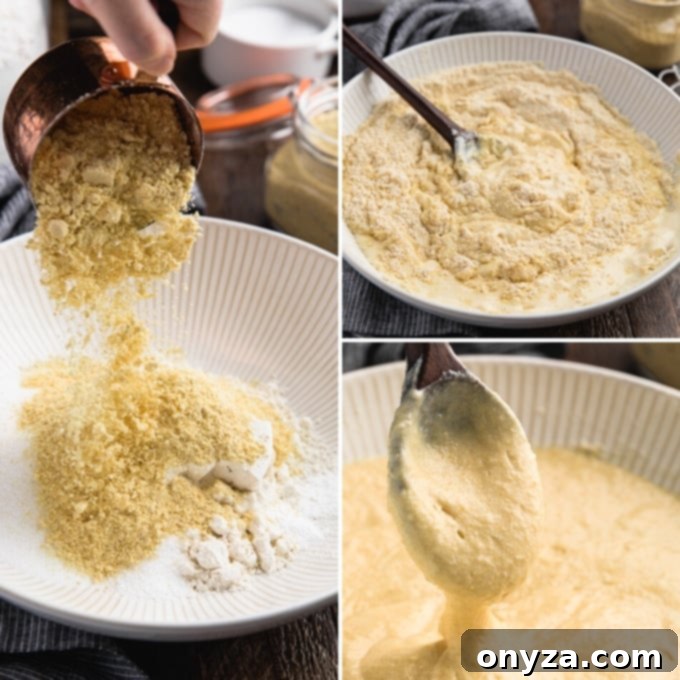
Baking Excellence: How to Make Buttermilk Cornbread
While this recipe might not be a single-bowl wonder, it is remarkably straightforward and perfect for when a craving strikes. The batter comes together incredibly quickly, often in less time than it takes for your oven to preheat. The process involves mixing the wet and dry ingredients in separate bowls before gently combining them, ensuring a perfect consistency every time.
Pro Tip: For the most tender and desirable cornbread texture, resist the urge to over-mix the batter once you’ve combined the wet and dry ingredients. A few visible streaks of flour here and there are perfectly fine, and even preferred, to avoid developing too much gluten, which can lead to a tough cornbread.
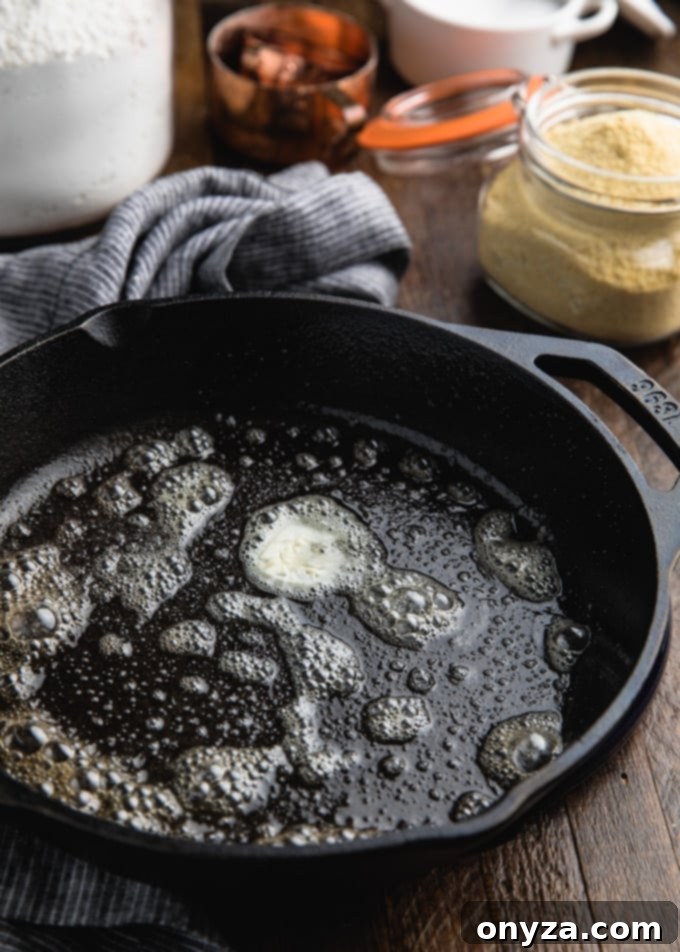
The Cast Iron Advantage: Achieving the Best Crust
Embracing a time-honored Southern tradition, I strongly advocate baking this buttermilk cornbread in a cast iron skillet. The unique heat-retaining and conductive properties of cast iron are truly unparalleled, yielding a golden, wonderfully crisp crust that provides a magnificent textural contrast to the fluffy, moist interior. This method is, quite simply, the best for achieving cornbread perfection!
For this recipe, an 8- to 9-inch cast iron skillet is ideal. To cultivate that enviable, deeply flavorful crust, a critical step is to preheat the skillet along with your oven. Simply place your empty cast iron skillet on the middle rack of a cold oven before you turn it on. By the time your oven reaches the target baking temperature, your skillet will be perfectly hot and ready.

Once your oven is preheated and your velvety batter is ready, carefully remove the searing hot skillet from the oven. Immediately add one tablespoon of cold butter to the pan. You’ll observe it instantly melting, bubbling, and foaming. Swirl the butter around to coat the entire bottom and sides of the skillet. The residual heat will beautifully brown the milk solids in the butter, imparting an incredibly wonderful, toasty, and nutty aroma and flavor directly into your cornbread.
When you pour the prepared batter into this perfectly hot, buttered skillet, you’ll notice it begins to bubble and set around the edges almost immediately. This initial sizzle is the magic at play, absolutely crucial for the development of that signature, irresistible golden crust that sets skillet-baked cornbread apart.
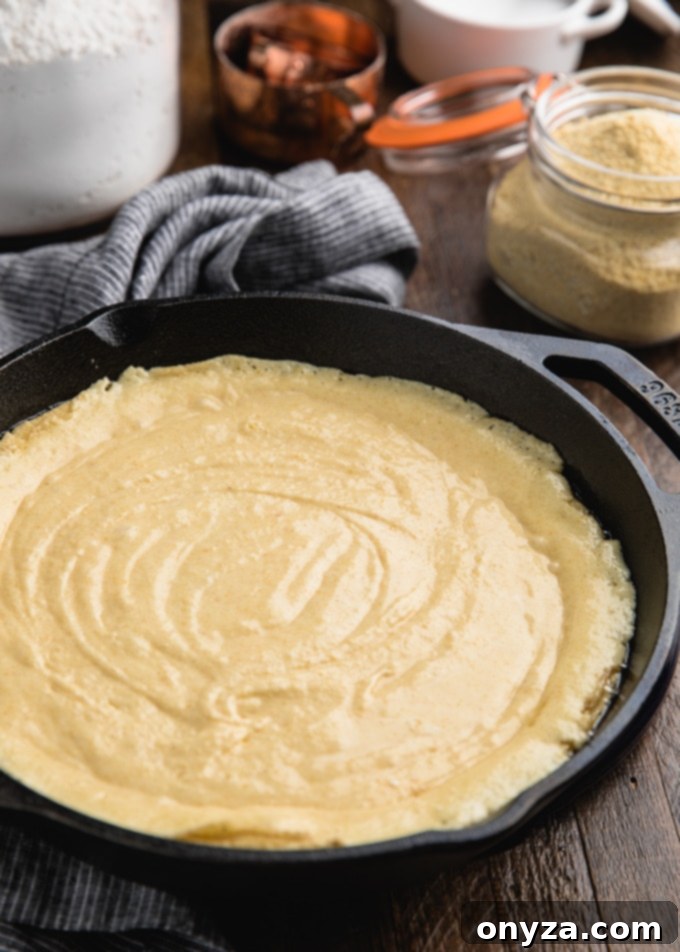
Important Note: The moment you’ve poured the batter into the hot pan, time is of the essence! Smooth it into an even layer in the skillet and transfer it back to the oven immediately. This swift action ensures the best possible crust and overall texture.
Can I Make This Buttermilk Cornbread Without a Cast Iron Skillet?
Absolutely, you can still enjoy this delicious buttermilk cornbread even if you don’t own a cast iron skillet. However, it’s important to understand that the cornbread might not develop quite as deeply colored or robustly flavored a crust. Instead of an 8 to 9-inch cast iron skillet, simply use a similarly sized round or square baking pan. Make sure to grease it well before adding the batter to prevent sticking.
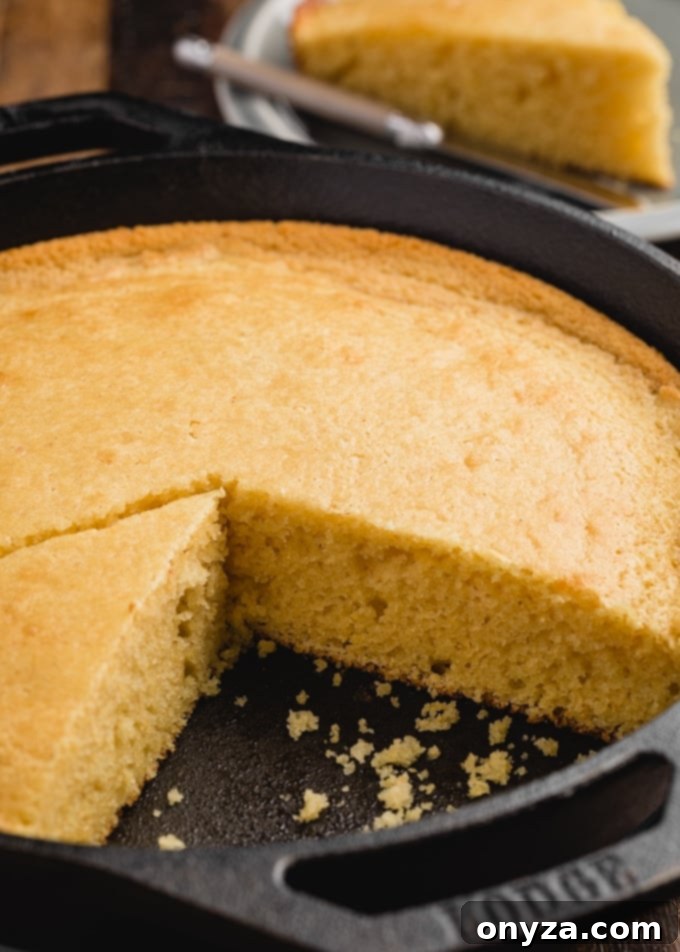
Serving & Storing Your Freshly Baked Cornbread
This buttermilk cornbread is truly at its peak when served on the day it’s baked. I recommend allowing it to cool for about 15 minutes in the skillet before slicing it into generous wedges and serving it warm, directly from the pan. This brief cooling period helps the cornbread set, making it easier to slice and ensuring it retains its delightful texture.
Enhancing Your Cornbread: Perfect Pairings
A simple slathering of whipped salted butter is often my preferred accompaniment – its creamy texture and subtle saltiness perfectly complement the cornbread’s rich flavor. However, the versatility of this cornbread allows for endless delicious toppings:
- Sweet Enhancements: We adore topping this cornbread with homemade honey butter or a fragrant maple butter. A decadent drizzle of hot honey also adds a wonderful sweet-spicy kick.
- Savory Kicks: For those who enjoy a bit of heat, a spread of roasted jalapeño butter is a fantastic choice, especially when serving the cornbread with savory main dishes.
- Beyond Butter: Consider fruit jams, apple butter, or even a dollop of whipped cream if serving as a dessert.
The choice of accompaniment truly depends on the main dish I’m serving alongside the cornbread, and whether I want to highlight its sweet or savory characteristics on any given day. It pairs beautifully with hearty stews, rich chilis, barbecue, fried chicken, or even as a unique addition to your breakfast table.
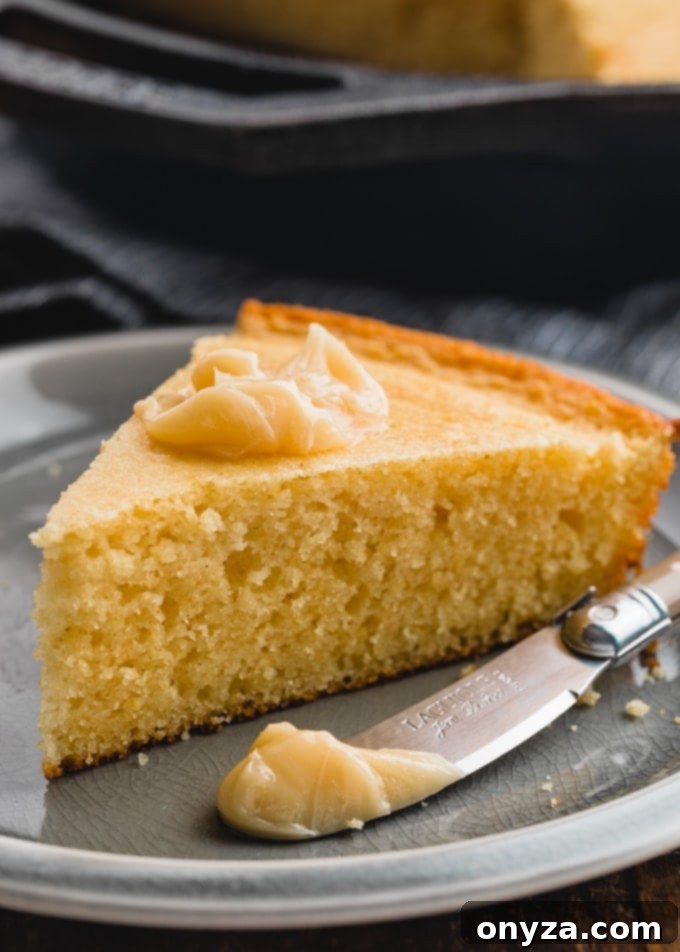
Can I Make This Recipe Ahead of Time?
While freshly baked is always best, there are ways to manage this cornbread ahead of time. You can store baked cornbread, tightly-wrapped in plastic wrap or foil, at room temperature for up to a day. Be aware that its texture will become denser and slightly drier as it sits. This denser texture, however, is often *preferable* if you plan to use it as an ingredient in other dishes, such as my popular Cornbread and Sausage Stuffing, where a slightly firmer crumb is desirable.
Freezing Cornbread for Later Enjoyment
Should you find yourself with delightful leftovers, this cornbread freezes exceptionally well and can be stored for 2-3 months. I frequently slice the cornbread into individual wedges before freezing. This allows for convenient portioning, letting me grab just a single slice without needing to defrost the entire round.
To freeze, ensure the cornbread has cooled completely to room temperature. Then, wrap each slice or the entire round in a double layer of plastic wrap, followed by a layer of aluminum foil. This dual protection helps prevent freezer burn. When you’re ready to enjoy it again, fully defrost the cornbread (either in the refrigerator overnight or at room temperature). For best results, re-wrap it in fresh foil and warm it in a 350-degree F (175°C) oven for 10-15 minutes, or until heated through.
Delicious Recipes to Serve with Your Buttermilk Cornbread:
- Roasted Chicken with Root Vegetables: The perfect comforting meal.
- Instant Pot Texas-Style Chili: A robust chili that’s beautifully complemented by a slice of warm cornbread.
- Hearty Beef Stew: The tender, slightly sweet cornbread is ideal for soaking up rich stew juices.
- Pulled Pork or BBQ Ribs: Cornbread is a classic companion to smoky, savory barbecue.
- Southern Fried Chicken: A match made in heaven for a true Southern comfort food experience.
- Any Creamy Soup: From tomato soup to broccoli cheddar, cornbread makes a delightful dipper.
CRAVING MORE? Don’t miss out on our latest culinary adventures! Subscribe to my exclusive newsletter to get new recipes and tips delivered straight to your inbox. You can also connect with me on Facebook, Pinterest, and Instagram for daily inspiration and behind-the-scenes glimpses!
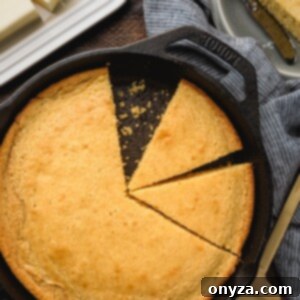
Buttermilk Cornbread
Equipment
- 8- to 9-inch cast iron skillet
- Large mixing bowls
- Whisk
- Heat-safe basting brush (optional, for butter distribution)
Ingredients
- 1 cup fine-grind yellow cornmeal (whole grain recommended)
- 1 cup all-purpose flour
- ⅓ to ½ cup granulated sugar (adjust to your preferred sweetness)
- ½ teaspoon baking soda
- 2 teaspoons baking powder
- 1 teaspoon kosher salt
- ⅔ cup buttermilk (whole buttermilk is preferred for richness, low-fat can be substituted)
- ¾ cup sour cream
- 2 large eggs
- 8 tablespoons unsalted butter (1 stick), divided
Instructions
- Position an 8- to 9-inch cast iron skillet on the middle rack of a cold oven. Preheat the oven to 400°F (200°C).
- In a large mixing bowl, whisk together the cornmeal, all-purpose flour, granulated sugar, baking soda, baking powder, and kosher salt until well combined. Set this dry mixture aside.
- Melt 7 tablespoons of the unsalted butter and allow it to cool slightly (this is important to prevent cooking the eggs). In a separate medium bowl, whisk together the eggs, buttermilk, and sour cream. Gradually whisk in the cooled melted butter. The mixture might appear slightly curdled due to the butter chilling and forming tiny clumps; this is a desired result and perfectly normal.
- Pour the wet ingredients into the bowl with the dry ingredients. Stir gently until *just* combined. Be careful not to overmix, as overworking the batter will result in a tough cornbread. A few small streaks of flour are acceptable.
- Carefully remove the preheated cast iron skillet from the oven. Immediately add the remaining 1 tablespoon of cold butter to the hot skillet. It will melt and foam instantly. Using a heat-safe basting brush or by tilting the pan, swirl the butter around to coat the bottom and sides thoroughly. Once the butter is fully melted and the foaming begins to subside (indicating some browning of milk solids), quickly pour the cornbread batter into the hot skillet, spreading it into an even layer. You’ll observe the edges of the batter beginning to set immediately.
- Return the skillet to the oven and bake for 20-25 minutes, or until the cornbread is beautifully golden brown on top and a wooden skewer or toothpick inserted into the center comes out with only a few moist crumbs attached.
- Allow the cornbread to cool in the skillet for about 15 minutes before slicing it into wedges. Serve warm with your choice of whipped butter, honey butter, or maple butter. Enjoy!
Notes
Nutrition Estimate (per serving)
Carbohydrates: 41g |
Protein: 7g |
Fat: 19g |
Saturated Fat: 11g |
Cholesterol: 96mg |
Sodium: 421mg |
Potassium: 259mg |
Fiber: 2g |
Sugar: 14g |
Vitamin A: 595IU |
Vitamin C: 0.2mg |
Calcium: 104mg |
Iron: 1.7mg
Nutrition information provided is an estimate and should be used as a general guide. Values may vary based on specific ingredients and preparation methods.
Please note that our recipes have been developed using the US Customary measurement system and have not been tested for high altitude/elevation cooking and baking.
